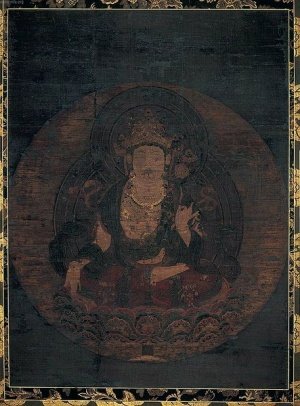Ākāśagarbha Bodhisattva
Ākāśagarbha Bodhisattva, known as Namkhai Nyingpo in Tibetan Buddhism, Xū kōng zàng pú sà in Chinese, 허공장보살 in Korean, and Kokūzō Bosatsu in Japanese, holds a significant place among the eight great bodhisattvas in Mahayana Buddhism. The name Ākāśagarbha can be translated as "boundless space treasury," emphasizing the limitless nature of wisdom.
1. Symbolism and Attributes:
Ākāśagarbha is often depicted holding a wish-fulfilling jewel, symbolizing the boundless treasures of wisdom.
The name "Ākāśagarbha" reflects the concept of boundless space or the womb of space, emphasizing the vast and all-encompassing nature of wisdom.
2. Role and Aspirations:
Ākāśagarbha is revered for his wisdom and compassionate vow to assist sentient beings on their path to enlightenment.
The bodhisattva's role is to provide profound wisdom, enabling practitioners to navigate the complexities of existence and attain a deeper understanding of reality.
3. Relationship with Ksitigarbha Bodhisattva:
Often considered the twin brother of Ksitigarbha Bodhisattva, the two bodhisattvas complement each other in guiding beings through the spiritual journey.
While Ksitigarbha focuses on compassion and alleviating suffering in the hell realms, Ākāśagarbha emphasizes wisdom and understanding.
4. Kūkai and Shingon Buddhism:
Kūkai, also known as Kōbō-Daishi, the founder of Shingon Buddhism in Japan, had a transformative experience with Ākāśagarbha.
Through repeated chanting of Ākāśagarbha's mantra, Kūkai received guidance to travel to China and seek understanding of the Mahavairocana Sutra, a pivotal scripture in Shingon Buddhism.
5. Mantra of Ākāśagarbha:
The mantra associated with Ākāśagarbha is considered powerful for invoking wisdom and understanding.
Different Buddhist traditions may have variations in the specific mantra, but it generally serves as a means to connect with the bodhisattva's enlightened qualities.
6. Mahavairocana Sutra and Spiritual Journey:
Kūkai's journey to China, prompted by the guidance of Ākāśagarbha, underscores the importance of seeking profound teachings.
The Mahavairocana Sutra played a central role in shaping Shingon Buddhism, emphasizing esoteric practices and the realization of the ultimate reality.
Conclusion: In Mahayana Buddhism, Ākāśagarbha Bodhisattva stands as a beacon of boundless wisdom, guiding practitioners through the expansive journey of spiritual awakening. Whether through symbolic depictions, revered mantras, or transformative encounters with figures like Kūkai, the presence of Ākāśagarbha continues to inspire seekers on the path to enlightenment, emphasizing the interconnected and limitless nature of wisdom.
1. OM (ཨོཾ):
Meaning: OM is a sacred sound and a spiritual icon in Hinduism and Buddhism. It represents the essence of the ultimate reality or consciousness.
Significance: In the context of the mantra, OM serves as a primordial sound, invoking the divine and setting the stage for the subsequent elements.
2. VAJRA (བཛྲ་):
Meaning: Vajra translates to "diamond" or "thunderbolt" in Sanskrit. It symbolizes indestructibility, strength, and the unyielding nature of enlightenment.
Significance: The inclusion of Vajra in the mantra emphasizes the unshakeable and powerful qualities associated with Ākāśagarbha's wisdom.
3. RATNA (རིན་པོ་):
Meaning: Ratna means "jewel" or "precious gem" in Sanskrit. It symbolizes the precious qualities of the teachings and the enlightenment that is sought.
Significance: The term Ratna reinforces the idea that Ākāśagarbha's wisdom is akin to a precious jewel, invaluable and illuminating.
4. TRAH (ཏྲ་):
Meaning: Trah is a Sanskrit word that can be translated as "protect" or "liberate." It implies a call for assistance or guidance.
Significance: In the context of the mantra, TRAH calls upon Ākāśagarbha to protect and guide practitioners on their journey towards enlightenment.
5. SOHA (སོ་ཧ་):
Meaning: SOHA is a Tibetan word that can be translated as "may it be so" or "amen." It is a common ending in many Tibetan mantras.
Significance: SOHA serves as a concluding affirmation, expressing the aspiration for the qualities invoked in the mantra to manifest in one's life.
Overall Significance:
The complete mantra, OM VAJRA RATNA TRAH SOHA, can be understood as a powerful invocation seeking the blessings and guidance of Ākāśagarbha Bodhisattva.
OM establishes a sacred and spiritual connection, while Vajra and Ratna emphasize the indestructible and precious nature of the wisdom associated with Ākāśagarbha.
TRAH calls for protection and assistance from the bodhisattva, and SOHA serves as a heartfelt affirmation that the qualities represented by the mantra may manifest in the practitioner's life.
Chanting and Meditation:
Practitioners often recite this mantra during meditation or as part of their daily spiritual practice to connect with the wisdom and guidance of Ākāśagarbha.
The repetition of the mantra is believed to purify the mind, open the practitioner to the bodhisattva's teachings, and cultivate the boundless wisdom symbolized by Ākāśagarbha.
In summary, OM VAJRA RATNA TRAH SOHA encapsulates the essence of Ākāśagarbha's wisdom, inviting practitioners to invoke and embody the qualities of indestructibility, preciousness, protection, and the fulfillment of aspirations on their spiritual journey.



